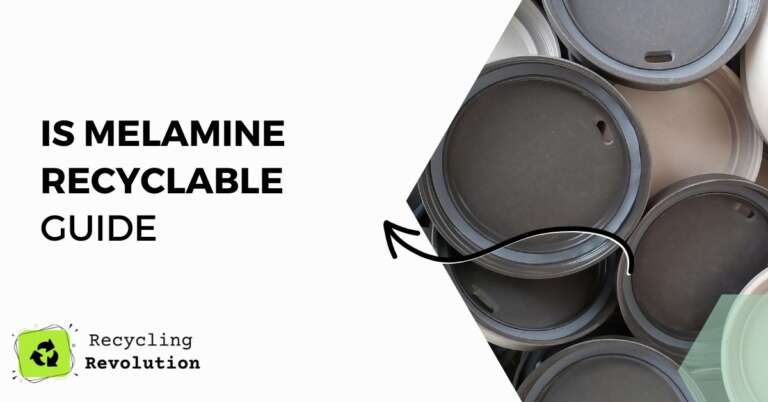Many people are asking this question, and there’s a good reason.
Melamine is a chemical that’s used to make dishes, tableware, and other kitchenware.
If you’ve got a melamine cup or plate, it might have been treated with formaldehyde resin to make it more durable.
But what happens when these products break down?
How long will it take for your melamine dishware to biodegrade?
This article will answer all your questions about this popular material and its environmental impact.
What Is Melamine Made Of?
Melamine combines formaldehyde and urea, a nitrogen-based compound found in urine.
The resulting chemical has a high melting point and is resistant to water and acidic solutions.
This makes it ideal for kitchens and bathrooms because it won’t break down in high heat or with exposure to water or acids, as some other types of plastic may.
Does Melamine Contain Plastic?
Yes, melamine is made of plastic.
The plastic used to make melamine is called polymelamine, a form of acrylic.
Acrylics are plastics that contain a large proportion of methyl groups (CH3).
Melamine is also known as melamine resin or melamine formaldehyde.
Is Melamine Recyclable?
The recycling process for melamine-containing items begins with crushing the item into small pieces.
These pieces are then sent through a shredder or grinder to further reduce their size before being placed into a container or conveyor belt for separation from other materials.
Next, they go through a magnetic separator to remove any metal shavings that the shredder or grinder may have left behind.
Finally, they go through an optical sorter that detects different shades of color so that all similar pieces can be recycled together as one batch of material.
Ways to Reuse Melamine
Wall Art
Melamine has a smooth surface, making it easy to paint or embellish with decals.
Use them as decor in your kitchen or dining area, or frame them for display in other house rooms.
Make Placemats
You can use melamine as a replacement for traditional dinnerware or as a way to add color to your table setting.
You can use them in the kitchen or dining room for everyday meals or special occasions such as birthdays and holidays.
Melamine is lightweight, making it easier to transport from room to room without worrying about breaking any dishes or glasses while moving them around.
The material is also easy to clean; wipe off any spills with a damp cloth or wash them in the dishwasher if they get too dirty.
Create a Tray
The most common way to reuse melamine is to cut them into smaller pieces and use them as trays for serving food or drinks at parties or other events.
You can also use them as serving trays in the kitchen or dining area at home.
Suppose you have several different sizes of melamine pieces left over from other projects.
In that case, you can create an interesting pattern by arranging them on top of each other or stacking them in a pyramid shape.
Make a Jewelry Organizer
Melamine is also useful in crafts projects like these DIY jewelry organizers made from plastic plates! This idea is excellent if you have small children who love playing with beads and other craft supplies — they’ll love having their little bin where they can keep all their favorite toys safe and organized.
Make Coasters
Turn a large board into coasters by cutting the board into four even squares, then sanding the edges smoothly.
Apply a thin layer of Mod Podge over the top side of each square, then place felt or cork on top of each square and allow it to dry completely.
Flip over your new coasters and paint them with acrylic paint or stain to match your decor.
Bird Feeder
Consider making your DIY bird feeder out of melamine if you have a yard full of birds.
All you need is a piece of melamine, a drill, and some metal wire or string.
Drill holes in the melamine plate and then hang it up outside with the string or wire through the holes.
The holes will allow the birds to eat from the plate while keeping their food safe from squirrels and other animals that might try to steal their snacks.
Melamine Impact On Human Health And Environment
Melamine is used in many products, including plastic dinnerware and building materials.
It has been associated with various health issues in humans, including cancer, kidney failure, and reproductive disorders.
Some studies have shown that the chemical may also affect the immune system, causing allergic reactions or anaphylactic shock when it comes into contact with the skin.
In 2008, melamine was found in pet food imported from China.
This contamination caused kidney failure in thousands of pets across North America, resulting in the deaths of hundreds of animals.
The FDA determined that melamine had leached into food or drink during use because it was not properly stable at room temperature.
When melamine is burned, it produces toxic smoke that can cause damage to human health and the Environment.
When exposed to high temperatures, melamine breaks down into formaldehyde gas and ammonia gas, both highly toxic chemicals linked to increased cancer risks.
Safety and Legal Policies
Make sure that you follow all recycling guidelines included with your product.
If there are no instructions on properly disposing of the product, contact your local waste management agency or city hall for further information.
Clean up any spills immediately.
Even non-toxic items like melamine can irritate if they come into contact with the skin or eyes.
If your spill involves food or drinkable liquids, call 911 immediately so that proper cleanup can begin.
If it does not involve food or drinkable liquids, call your local poison control center for further instructions on cleaning up the spill safely without causing harm to yourself or anyone else around you.
Conclusion
Melamine is not recyclable, but there is a way to reuse it.
While some toss it in the trash or down the drain, others can take it to hazardous waste depots.
Frequently Asked Questions
Is Melamine Toxic To The Environment?
Melamine is not highly toxic to the environment. However, it can have environmental impacts if it is released into the environment in large quantities. It is important to carefully manage the use and disposal of melamine to minimize its potential impacts on the environment.
Is Melamine Non Biodegradable?
Yes, melamine is non-biodegradable. It is a synthetic compound that is used in the manufacture of plastics, adhesives, and coatings. Melamine is not biodegradable, so it can persist in the environment for long periods of time. This can potentially lead to the build-up of melamine in the environment over time.

